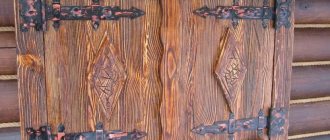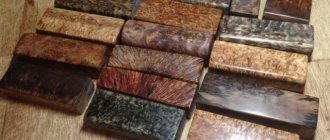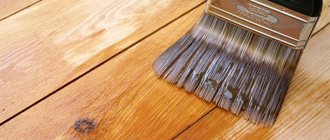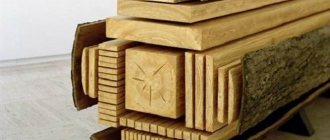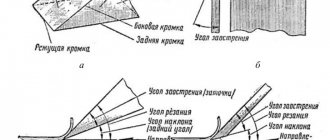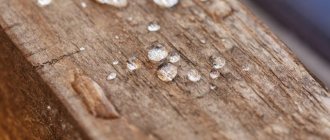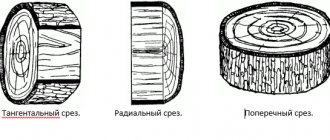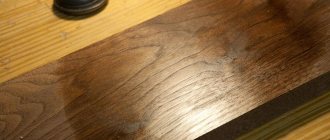Wood has unique characteristics that create ideal conditions for human habitation in a wooden house. Wood boasts properties that are not found in any other building material. It is environmentally friendly and safe, has a beneficial effect on human health, has a healthy aroma, creates an optimal level of humidity in the house and ensures good air exchange. However, wood has one significant drawback: it is very vulnerable; under the influence of humidity, precipitation, temperature changes, and microorganisms, it begins to rot and collapse. An effective method of protecting timber and log houses is treating the wood with an antiseptic, which prevents and blocks the development of negative processes.
The need for antiseptic treatment
Wooden surface before and after treatment
What natural factors negatively affect the health of wood:
- Water in all its forms (rain, snow, ice) and high air humidity lead to rot, mold and destruction of wood.
- UV radiation causes logs to age and crack.
- Insects and microorganisms, settling inside the tree, cause destruction of its structure.
Antiseptic treatment of wooden structures allows you to solve the following problems:
- prevents moisture from being absorbed into the wood structure, which prevents rotting;
- protects wood from bugs and fungal damage;
- protects the walls of the log house of the bathhouse and residential building from ultraviolet radiation;
- increases the service life of a wooden structure;
- improves the aesthetic characteristics of a house made of timber, a log house made of rounded logs, or a frame house.
Antiseptic treatment is required for all wooden houses without exception, regardless of the method used for further finishing: painting the walls of the house with paints or covering the facade with siding.
Why do you need to antisepticize wood? Is there any reason?
Yes, this significantly extends its service life. After a tree is cut down, the wood becomes inanimate organic matter, which, according to the laws of nature, sooner or later must turn into a substrate for the nutrition and growth of plants of future generations. This is a natural and necessary natural process. In the ecosystem, this important work is carried out by fungi and insects. However, if we are talking about the use of wood by humans in their economic activities, then such wood must be preserved for as long as possible. Therefore, there is a set of measures to extend the life of wooden structures and products. You can read about this in the article “ Types of biological damage to wood .”
When to treat
When to treat a log house with an antiseptic? Log processing is carried out in several stages. Primary treatment is always carried out before construction. It is impossible to build a house from untreated logs.
Pre-treatment ensures deep penetration of the composition into the wood structure and allows you to protect the lumber for a long time.
Often, manufacturers offer timber and logs already coated with protective impregnation. Such lumber is sold at a higher price, but by purchasing treated logs, you can skip the first stage of antiseptic treatment and immediately begin construction.
If you purchased untreated logs or lumber with natural moisture, then you need to treat the house yourself.
The following processing is carried out immediately after the construction of the log house. The work must be done with safe water-based compounds that do not interfere with air exchange and allow the wood to dry evenly during the shrinkage period.
The last time the log house is coated with antiseptic agents is after grinding, when the structure has undergone initial shrinkage. Houses made of timber can be processed approximately six months after construction, and log houses made of rounded and chopped logs should last a year and a half.
The exact processing time depends on the moisture content of the lumber; the wood should not be damp. The optimal humidity during the treatment period is 19-20%.
It is recommended to coat a wooden house with antiseptics every 5-10 years, depending on the type and quality of finishing.
Does the time of year matter for more effective tree pest control?
Since the woodcutter larva develops in the volume of wood for several years, for its elimination it is essential whether the wood is treated with the preparation volumetrically. This impregnation can be done at any time, methodically and without haste. As for other stages of insect development, the stage of a sexually mature insect (imago) is dangerous. In central Russia, maximum adult activity is observed from mid-May to the end of June. At this time, females lay eggs, from which young larvae hatch. If by this time the wood has not been treated superficially, then the larvae penetrate safely into the thickness of the wood and belated surface treatment will not affect their development in any way, since they do not come out. It is advisable that the wood be surface-impregnated in advance with an antiseptic containing active substances against insects ( Lignofix Stabil Extra, Lignofix I-Profi, Lignofix TOP ). And, best of all, do this before assembling the house. And the active substances themselves, such as insect development regulators - fenoxycarb and flufenoxuron - remain effective for at least 10 years.
Types of antiseptics
Today there are many antiseptic agents.
There are various drugs on store shelves, differing in active substance, composition, localization of processing, and principle of action. It is very important to choose the right product, since the effectiveness of the treatment directly depends on the chosen drug. Basic requirements for protective equipment:
- possessing antifungal, insecticidal and antimicrobial effects;
- providing protection from UV radiation and moisture;
- safety for humans;
- no pungent odor;
- stability of the active substance.
So that you can decide which antiseptic to choose to protect wood from rotting, the classification and types of drugs are given below.
All antiseptics are divided into two large types:
- Impregnating compositions. They penetrate very deeply into the wood, protecting it from external influences. Well suited for processing lining, houses made of otsb and timber before painting.
- Covering agents. They form a transparent or opaque film on the surface that protects the wood from harmful factors. Transparent compounds are less stable and require re-processing after 2-3 years.
Depending on the place of treatment, the products are:
- external;
- internal.
The main characteristics that products intended for treating the outside of a wooden house must have are resistance to external factors and provision of high-quality and effective protection of wood.
The compositions may contain toxic components; they often have a specific odor that does not disappear for a long time, so they cannot be used for work inside the house. But they are perfect for processing the external walls of wooden structures, timber for a greenhouse, and the outer part of a bathhouse frame. Interior compositions do not contain harmful substances or unpleasant odors, so they can be used to safely treat interior walls, floorboards, partitions and other elements of premises. The products ensure the safety of wood and at the same time are completely safe for humans.
Antiseptics for wood processing are divided into:
- water soluble;
- organic;
- oil;
- waxes.
Water-soluble products
Antiseptics of this group have good penetrating ability; they are absorbed into the wood structure up to 10 mm, therefore they are effective in any climatic conditions. They are absolutely safe, odorless products.
These compounds are based on water, so they are used only on surfaces that are not exposed to moisture, since the coating can wash off over time and the wood will be left without protection. If the products are used externally, treatment must be repeated at least once every three years, and internally - once every five years.
Organic antiseptics
They are based on organic solvents, due to which the products have a sharp, unpleasant odor that disappears no earlier than seven days. Therefore, organic preparations are used only for external treatment.
Antiseptics penetrate 5 mm into the wood structure, creating a thin film on the surface that does not allow moisture to pass through, but at the same time is vapor-permeable.
Oil formulations
Oil-based compositions penetrate deeply into the structure and reliably protect wood from moisture, dirt and dust. Impregnations are made on the basis of different oils. This can be shale, coal, linseed, hemp and other types of oils.
Under the influence of the product, the wood acquires a dark shade. Depending on the type of oil, impregnation can be used for both external and internal work. The antiseptic creates a stable, indelible film.
Natural wax
This is a traditional product that has been used for centuries to treat wooden houses. The wax saturates the wood well, forming a protective layer that protects the wood from bugs, ultraviolet radiation and moisture. Wax is great for use in high temperature areas.
If you are interested in the question: how to treat a log bathhouse from bark beetles and natural factors, then the best product for treating steam rooms and saunas is difficult to find.
New house. When do you need to antisepticize wood when building a house?
The sooner you treat the material with an antiseptic, the better. Timely preventive treatment with an antiseptic helps to avoid wood contamination - treatment is always more difficult and more expensive. It is recommended to use antiseptics before assembling the log house, as this allows you to apply the drug to all surfaces that will then become inaccessible. Use Lignofix Stabil Extra . If the manufacturer of building materials has not treated them with a temporary (transport) antiseptic, wood deterioration may begin even before construction begins.
Basic rules for antiseptic treatment
In order for the antiseptic to become a reliable protection for the frame and walls of a wooden house, it is necessary to carefully prepare the wood. The surface to be treated must be clean and dry. In order for the wood to better absorb the antiseptic composition, it must be sanded well.
If an old house is subjected to antiseptic treatment, you need to remove the previous coating and remove defects (putty on cracks, dents and irregularities).
Antiseptic treatment can be carried out at an external temperature of at least +5 degrees. Air humidity should be about 80%.
There are different ways to treat wood with antiseptics: roller, brush or spray. The first two methods are quite labor-intensive, but they allow you to thoroughly treat all hard-to-reach areas. Using a spray gun makes the job faster and easier, but you may miss the most secluded places. Therefore, it is better to combine both methods.
The antiseptic is applied in 2-4 layers, depending on the condition of the wood. After finishing the work, the treated surface is left to dry. Finishing of the house begins only after the wood has completely dried.
What are wood preservatives made of? Composition of antiseptic preparations Lignofix
Unlike many manufacturers who hide the composition of their wood preservatives or use only general words in their descriptions, the drug manufacturer Lignofix provides detailed information not only about the active ingredients, but also about their quantity. You can find detailed information about each active ingredient in the material: Detailed composition of antiseptics for wood Lignofix . Try to find such information from Russian manufacturers of wood antiseptics.
Rating of antiseptics
To make it easier for you to decide how best to treat a wooden house, below is a rating of antiseptics.
Belinka (Slovenia). Deep penetration antiseptic, provides effective protection against UV radiation, moisture and insects.
Senezh (Russia). The company produces more than twenty types of antiseptics, which are of high quality at an affordable price. If you are interested in how to get rid of mold on the walls of a wooden house, then the preservative antiseptic Senezh, which is effective even in the most severe cases of biological damage to wood, is perfect for these purposes.
Neomid (Russia). Affordable and high-quality universal products that are suitable for deep and decorative processing.
Do wood antiseptics contain poisons? Are Lignofix antiseptics dangerous for humans?
Unlike many other products, Lignofix antiseptics do not contain heavy metal compounds: copper, chromium and other substances toxic to humans and warm-blooded animals. Lignofix's advanced antiseptic formulas are based on creating balanced proportions of fungicides, insecticides and antiseptics used in medicine and agriculture. Insect growth regulators are used. However, refusal to use toxic drugs does not negatively affect their effectiveness in destroying wood-destroying bioagents: mainly fungi and insects. Unlike many Russian manufacturers, all ingredients of all Lignofix products are indicated. You can find detailed information about each active ingredient in the article: Detailed composition of antiseptics for Lignofix wood .
Operating principle of protective equipment
Wood impregnations kill insects and prevent the appearance of fungus on the surface of the material, similar to medications that cure and prevent the development of disease in the human body. It is much less expensive and simpler to prevent the occurrence of rot and harmful organisms than to try to get rid of them later.
The role of impregnations is played by substances of chemical origin that have different etiologies and structures. There are products that are effective on their own and do not require any auxiliary solutions, but sometimes an integrated approach to processing using several compounds is necessary. After all, there are microorganisms that are resistant to negative influences and require serious measures to be destroyed.
The period of active protection of antiseptics varies and can vary from several days to 7 years or more. There are products that affect the material only at a superficial level, while others penetrate deeper and protect it from the inside.
A primitive composition can be made independently at home; for example, it has long been known that treatment with lime makes timber resistant to rot. Still, it is better to resort to more modern and effective synthetic mixtures produced in laboratory conditions, which work comprehensively in several directions. Do not forget that it is important to carefully read the instructions for use and follow them carefully, since improper use can lead to serious consequences, for example, poisoning with toxic fumes.
Technology for treating logs and beams with an antiseptic. Experience and Tips on wood preservatives
Nowadays suburban construction is very developed. All city residents try to buy or build themselves a cozy house away from noisy and dusty cities, and at least from time to time be closer to nature. That is why the demand for natural materials – logs and beams – has increased. Before sale, they must undergo factory processing, which necessarily includes antiseptic treatment. But, unfortunately, not everyone does it due to lack of time or finances. Therefore, it is necessary to independently treat logs or beams with antiseptic compounds immediately after construction, but to achieve the best result, you must adhere to the processing technology.
How to prepare bioprotection for wood at home
You can independently prepare biogen to protect lumber either on the basis of bitumen (resin) or on the basis of a salt-water mixture.
The first method or a mixture of bitumen for application to the surface of wood is effective against rot and pests. To prepare it, you need bitumen, as well as a diluting agent - gasoline or diesel fuel. It is thanks to diesel fuel that the preparation will harden longer and its penetration into the surface of the wood will be deeper. Gasoline, when used in a solution, can speed up the solidification process of the mixture. It should be used if construction work is limited in time.
You can buy bitumen solvents at every gas station, and used motor oil at service stations. Bitumen is sold either in construction stores or at construction sites. When purchased at a hardware store, bitumen has higher viscosity and good packaging, which increases its transportability.
When purchasing fuel at a gas station, you should always use metal containers, otherwise static discharge from other materials can lead to fire and varying degrees of burns.
In addition to the solution ingredients described above, in order to prepare an antiseptic with your own hands, you need additional equipment:
- a metal container to heat the bitumen;
- metal spatula for mixing the solution;
- stops to fix the container above the fire.
You can prepare a mixture based on bitumen as follows:
- Immerse bitumen in the container;
- place the container over the fire;
- heat until the bitumen is completely melted, stirring until the lumps dissolve;
- when the bitumen has a weak viscosity, remove the container from the heat and let it cool slightly;
- After cooling, mix the bitumen with a thinner, which is recommended to be added in small portions so that it does not evaporate.
The proportion of bitumen and solvent depends on the state in which the bitumen was initially found. An important measure is whether the resulting mixture remains fluid at a temperature of 18-20 °C. The share of fuel in the mixture is approximately twenty to thirty percent of the resulting volume of the composition. At the same time, the viscosity of bitumen has an effect on it, under which the composition percentage can change.
If the bitumen container is heated quickly, the mixture may overflow directly into the fire. The cause of overflow and bubbling of the mixture is water from the bitumen composition. When heated slowly, the mixture does not overflow and the water does not boil away. Based on the volume of lumber, it takes from two hours to a whole day to prepare a bitumen antiseptic. The resulting preparation has good viscosity and adhesiveness to the top layer of any wood. The resulting mixture is not stored for a long time, so it is used immediately after cooling.
It is recommended to make the bitumen preparation outdoors in order to reduce the likelihood of poisoning by toxic fumes to 0 and reduce the fire hazard. The resulting antiseptic must be applied with a brush or roller with a long handle. You can also impregnate lumber with it by simply immersing parts of the wood in a container with the mixture. Once the bitumen layer dries, it is difficult to disturb. Therefore, such structures are not afraid of contact with the ground.
Another way to prepare wood antiseptic yourself is to prepare a salt-water solution. This solution can be prepared through a chemical reaction between a certain amount of salt and water. To increase the catalytic activity of water, it is heated. As a result, an antiseptic preparation for processing timber is formed. There are different proportions for the antiseptic sodium fluoride and copper or iron sulfate:
- impregnation of lumber in buildings and domestic structures requires a weak mixture of sodium fluoride and water. The proportion of this substance relative to water will be 50-400 g per bucket. Additionally, when treating indoors, weaker mixtures are recommended for use, while outdoors it is worth using more concentrated solutions. To visually understand whether the drug has been completely applied, 10 grams of potassium permanganate are added to the solution. The bright color does not last long and will disappear once the surface is covered. This solution is applied either with a roller, or with a wide brush, or with a spray bottle.
- To treat wooden structures in contact with the ground, sulfate solutions are used with a sulfate content of 1-2 kg per bucket of water. To improve the effect of such mixtures, it is necessary that the lumber is dry and the impregnation is long-lasting. The application of an antiseptic can also be visually determined by the color saturation of the vitriol. Parts of the wood are soaked in the resulting antiseptic, which will subsequently be exposed to negative environmental influences.
To prepare an aqueous solution you will need hot water, a mixing container and a stirrer. You can use the mixture after it has settled and cooled, having previously loaded it into the spraying apparatus. It is spraying that allows you to evenly cover the surface of the wood with the mixture and reduce its consumption. In this case, the solution has a shelf life of several days; processing can begin when suitable weather conditions have established.
Such antiseptics can be prepared both indoors and outdoors. When preparing at home, you need to be careful and make sure that the antiseptic does not get on your clothes or in crevices with difficult access. This solution can be prepared for up to an hour.
To avoid errors when measuring proportions for the composition, you must first familiarize yourself with the characteristics of the wood that is to be processed.
Therapeutic and preventive antiseptics for wood - what is the difference?
These groups of antiseptics are somewhat different in the composition of active (biocides) and auxiliary (for better penetration, etc.) substances and their quantity, since they do not perform exactly the same tasks.
However, medicinal compositions can also be successfully used as prophylactic for impregnation of healthy wood. But, since they are more expensive, it is more advisable to use prophylactic drugs for preventive measures.
Preventive medications are used on healthy and new wood to prevent infection with wood-destroying bioagents (fungi, insects). Fungal spores and beetle larvae, once on a surface treated with such compounds, become non-viable and, therefore, cannot cause harm to the wood.
To increase efficiency, it is recommended to use preventive antiseptics before assembling the house, since after that some surfaces become inaccessible.
In some cases, it is possible to use preventive compositions as therapeutic ones, then the concentration of the working solution should be increased and part of the water should be replaced with ethyl alcohol for deeper penetration into the wood. You should first consult with specialists.
Therapeutic sanitizing compounds are used on affected wood to destroy existing destroyers. Preventive antiseptics are applied to the remaining uninfected part of the surfaces, but sometimes therapeutic ones are also used, as indicated above.
Folk remedies for impregnating wood
Not everyone has the desire or ability to buy expensive wood processing products. Purchased options are good because they have pre-known properties and certain quality and do not require lengthy preparation. Open it, stir it and start working. Traditional methods used to protect wood are much cheaper, but their preparation is a whole process. And the properties and the result depend on the observance of proportions and/or sequence of actions.
Not the only layer is involved in protecting wood from rotting and moisture.
Copper sulfate as an antiseptic for wood
Copper sulfate is transparent blue granules. Sold in small packages of 20–500 grams, there are kilogram packages, sometimes in bags of 20–50 kg. It's inexpensive. Using products based on it, you can treat wood against mold, fungi and other biological damage.
Copper sulfate as a means to protect wooden structures
Copper sulfate actively corrodes metals, so do not use metal containers or tools for work. Only plastic or glass.
How to make impregnation for protection from copper sulfate
An aqueous solution of copper sulfate is a good antiseptic for wood. Does not change color after treatment, but fades or is washed out over time. So such a budget replacement is suitable instead of a transport antiseptic. It is suitable for processing dry or seasoned wood.
- Aqueous solution for wood. Per liter of soft warm water 5–10 grams of copper sulfate. Stir until completely dissolved. When applied with a brush, apply at least twice when the first layer is completely dry. Approximate consumption for double application is 0.9-1 l/m². This method is good before storage or before finishing. It is important to dry the material after coating.
Temporary protection can be done using a solution of copper sulfate - For wooden elements that will be in direct contact with the ground, soaking in a solution of copper sulfate is required. The solution is made more concentrated - 20% or higher. That is, dissolve 200 grams of copper sulfate in 1 liter. Immerse the wooden elements in the resulting solution for 2 days. Having taken it out, we dry it for a month under a canopy in a ventilated stack. Posts treated in this way can be buried in the ground without any fear, and flooring or decking boards will last at least 20 years.
This is an inexpensive way to protect wood from rot and fungi. Using copper sulfate you can achieve non-flammability. To do this, add copper sulfate to the lime solution. A board whitened in this way becomes non-flammable.
Iron sulfate for wood protection
Another inexpensive antiseptic that can replace factory-made antiseptic is iron sulfate. It is used in gardening, so it can be found in stores of this specialization. The properties are approximately the same, but the compositions for processing are more complex, both in terms of the number of ingredients and the preparation technology. These compositions were invented by the Swedes and Finns, whose traditions of building with wood are no less ancient than ours.
Iron sulfate (iron sulfate) is green granules. Used in gardening
Finnish recipe for protective paint
Finnish recipe for protective impregnation of wood. It will even preserve the fence for decades. The accuracy of dosage and preparation sequence is important here. We take the following ingredients:
- 9 liters of water;
- 1560 each of iron sulfate and dry lime, ground into powder or dry lime pigment;
- 720 g rye flour;
- 360 g kitchen salt.
You can cook paint with antiseptic properties yourself and cheaply.
If you want a guaranteed result, do everything exactly, don’t change anything. There are already many options for replacing ingredients, but how long the modified recipe will last is unknown.
How to cook
The cooking sequence is as follows. Gradually add 6 liters of water to the flour, stir until smooth. You should get liquid sour cream. It will be easier and faster if you use a construction mixer. You will stir for a long time without heating with a wooden stick. As a compromise solution, stir with a stick until the lumps are completely dissolved, then warm up a little.
If you add red pigment, you get something like this color
Boil the rest of the water (3 liters) and gradually pour in, without ceasing to stir. The result is a paste of medium thickness. We put it on the fire, stirring, pour in salt, iron sulfate and lime powder or dry lime pigment. The result is not only impregnation, but also paint, the color is brownish-brown. That is, we not only protect the wood with one composition, but also paint it.
How to get a different color and how to apply
If you need a color other than brown, we get it by using lime pigment. But remember that the original color is brownish-brown. You won't get blue or light gray based on it. Red brick, ocher and other similar ones are easily obtained. You can select a specific color using trial batches.
The paint is applied to the wood with a brush in two layers. Apply the second layer after the first has completely dried. Over time, the color changes slightly and becomes lighter.
Swedish recipe for wood protection paint
It differs in composition, but the preparation technology is similar. The base color is brown. The ingredients needed are:
- 9 liters of water;
- 520 grams each of iron sulfate, salt and lime pigment;
- 480 grams of natural drying oil;
The preparation procedure is similar; drying oil is added at the end of the process. There are options in which 260 grams of iron sulfate and the same amount of red lead are taken. The color of the composition shifts towards yellow. That is, it is easier to obtain green shades based on it.
Application rules
Both wood protection impregnations - Finnish and Swedish - are applied to boards or logs that have not been painted before. Resinous varieties are best deresined. To do this, they are treated with a solution of soda ash (50–100 grams of soda ash per liter of water). Apply a warm solution (temperature at least 40 °C) twice, then rinse with warm water. Dried wood can be painted.
Iron sulfate is included in homemade paint for wood processing
It is better to apply Finnish and Swedish wood protection compounds on a cloudy day. Or choose a time so that the sun does not shine on the treated surface. After drying, the paint, even with mechanical impact, does not wear off. During precipitation, colored water may flow, but this does not particularly affect the appearance. Such treatment will preserve wooden products that are outdoors for 20 years or more.
Finnish and Swedish impregnation paint is applied in two layers. Before applying the second one, wait until the first one is completely dry. This may take more than one day. The thick binder is absorbed slowly. The drier the wood before painting, the faster it will dry.
Why wood needs to be protected
If air humidity exceeds 15%, the wood swells and delaminates, and then cracks. Cracks and gaps form on the surface. Temperature changes also do not prolong the life of wood: they periodically expand and contract. Condensation accumulates in the pores, which contributes to the development of fungus and mold. Wood-boring beetles penetrate through the untreated surface, capable of turning the dense structure into a kind of sieve.
Wood that is rotten and damaged from the inside decreases its density, and the entire structure loses its strength characteristics, and there is a risk of loosening and destruction of the house. It turns out that protecting the material from excess moisture is also a matter of safety, and not just aesthetics.
Exotic rattan wood is not afraid of excess moisture
Microorganisms formed from dampness harm the health of those who live in a wooden house. They release spores that enter the lungs and contribute to the development of chronic diseases and allergies.
Differences between hand-made antiseptics and ready-made ones from the factory
Among the advantages of self-made preparations for wood processing in comparison with purchased factory-produced analogues, the following can be identified:
- the cost is lower;
- if the treatment occurs with a bitumen or oil composition, then the effectiveness of the effect increases;
- less toxicity;
- the chance that the antiseptic will be of low quality is almost zero.
At the same time, they are inferior to factory-produced drugs:
- efficiency is higher with factory-made drugs;
- factory ones are easy to prepare, that is, if you follow the instructions, they can be quickly prepared by simply mixing with a solvent;
- Factory antiseptics have a selective effect on wood.
Fire retardants and antiseptics are required to protect wood so that buildings and structures last longer. You should not look for the best antiseptics for wood, but you should first understand what is expected from them, and only then choose. Each group has its own leaders.

